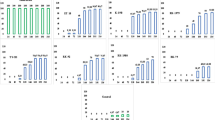Abstract
The activity of different types of natural compounds and of two biofungicides based on Bacillus subtilis and Ampelomyces quisqualis alone and in combination with fungicides was tested against powdery mildew of zucchini. The efficacy was compared to the activity of fungicides used alone in four experimental trials carried out in the open field and under greenhouse conditions. The Podosphaera xanthii population used throughout the work was partially resistant to azoxystrobin, whereas it was susceptible to mychlobutanil. Sulphur plus terpenes and mustard oil consistently controlled powdery mildew, followed by mychlobutanil alone or in combination with A. quisqualis. B. subtilis and A. quisqualis when tested alone were partially effective. The combination of azoxystrobin and B. subtilis only delayed the spread of the pathogen.
Similar content being viewed by others
References
Braun, U., & Takamatsu, S. (2000). Phylogeny of Erysiphe, Microsphaera, Uncinula (Erysipheae) and Cystotheca, Podosphaera, Sphaerotheca (Cystotheceae) inferred from rDNA ITS sequences – some taxonomic consequences. Schlechtendalia, 4, 1–33.
Copping, L. G. (Ed.). (2004). The manual of biocontrol agents. Alton, Hampshire, UK: British Crop Protection Council.
EPPO. (2004). EPPO Standards PP1 (2nd ed., Vol. 2). Paris, France: European and Mediterranean Plant Protection Organization.
Gilardi, G., Manker, D. C., Garibaldi, A., & Gullino, M. L. (2008). Efficacy of the biocontrol agents Bacillus subtilis and Ampelomyces quisqualis applied in combination with fungicides against powdery mildew of zucchini. Journal of Plant Diseases and Protection, 115, 208–213.
Hagiladi, A., & Ziv, O. (1986). The use of antitranspirants for the control of powdery mildew of roses in the field. Journal of Environmental Horticulture, 4, 69–71.
Heaney, S. P., Hall, A. A., Davies, S. A., & Olaya, G. (2000). Resistance to fungicides in the QoI-STAR cross-resistance group: current perspectives. Proc. British Crop Protection Conference on Pests and Diseases, 2, 755–762.
Hofstein, R., Daoust, R. A., & Aeschlimann, J. P. (1996). Constraints to the development of biofungicides: the example of AQ 10, a new product for controlling powdery mildews. Entomophaga, 41, 455–460.
Horst, R. K., Kawamoto, S. O., & Porter, L. L. (1992). Effect of sodium bicarbonate and oils on the control of powdery mildew and black spot of roses. Plant Disease, 76, 247–251.
Huggenberger, F., Collins, M. A., & Skylakakis, G. (1984). Decreased sensitivity of Sphaerotheca fuliginea to fenarimol and other ergosterol-biosynthesis inhibitors. Crop Protection, 3, 137–149.
Ishii, H. (2010). QoI fungicide resistance: current status and the problems associated with DNA-based monitoring. In U. Gisi, I. Chet, & M. L. Gullino (Eds.), Recent developments in management of plant diseases (pp. 37–45). Dordrecht, the Netherlands: Springer.
Jacobsen, B. J., Zidack, N. K., & Larson, B. J. (2004). The role of Bacillus-based biological control agents in integrated pest management systems: plant diseases. Phytopathology, 94, 1272–1275.
Keinath, A. P., & DuBose, V. B. (2004). Evaluation of fungicides for prevention and management of powdery mildew on watermelon. Crop Protection, 23, 35–42.
Manker, D. C. (2005). Natural products as green pesticides. In J. M. Clark & H. Ohkawa (Eds.), New discoveries in agrochemicals (pp. 283–294). Washington, DC: American Chemical Society.
Marrone, P. G. (2002). An effective biofungicide with novel modes of action. Pesticide Outlook, 13, 193–194.
Martin, B., Hernandez, S., Silvarrey, C., Jacas, J. A., & Cabaleion, C. (2005). Vegetable, fish and mineral oils control grapevine powdery mildew. Phytopathologia Mediterranea, 44, 169–179.
Matheron, M. E., & Porchas, M. (2000). Evaluation of fungicide performance for control of powdery mildew on lettuce in 2000. Online publication no. AZ1177 in: Vegetable: College of Agriculture Report 2000. College of Agriculture, University of Arizona, Tucson, AZ, USA.
McGrath, M. T. (2001). Fungicide resistance in cucurbit powdery mildew, experiences and challenges. Plant Disease, 85, 236–245.
McGrath, M. T. (2007). Managing cucurbit powdery mildew and fungicide resistance. Acta Horticulturae, 731, 211–216.
McGrath, M. T., & Shishkoff, N. (1999). Evaluation of biocompatible fungicides for managing cucurbit powdery mildew. Crop Protection, 18, 471–478.
Pasini, C., D’Aquila, F., Curir, P., & Gullino, M. L. (1997). Effectiveness of antifungal compounds against rose powdery mildew (Sphaerotheca pannosa var. rosae) in glasshouses. Crop Protection, 16, 251–256.
Paulitz, T. C., & Bélanger, R. B. (2001). Biological control in greenhouse systems. Annual Review of Phytopathology, 39, 103–133.
Reuveni, R., & Reuveni, M. (1998). Foliar-fertilizer therapy – a concept in integrated pest management. Crop Protection, 17, 111–118.
Romero, D., Devicente, A., Rakotoaly, R. H., Dufour, S. E., Veening, J. W., Arrebola, E., et al. (2007). The iturin and fengycin families of lipopeptides are key factors in antagonism of Bacillus subtilis toward Podosphaera fusca. Molecular Plant-Microbe Interactions, 20, 430–440.
Shishkoff, N., & McGrath, M. T. (2002). AQ10 biofungicide combined with chemical fungicides or AddQ spray adjuvant for control of cucurbit powdery mildew in detached leaf culture. Plant Disease, 86, 915–918.
Sitterly, W. R. (1978). Powdery mildew of cucurbits. In D. M. Spencer (Ed.), The powdery mildews (pp. 359–379). London, UK: Academic Press.
Winer, B. J. (1962). Statistical principles in experimental design (2nd ed.). New York, NY: McGraw-Hill.
Zitter, T. A., Hopkins, D. L., & Thomas, C. E. (1996). Compendium of cucurbit diseases. St. Paul, MN, USA: APS Press.
Acknowledgments
This work was carried out with a grant from “Valorizzazione dell’orticoltura transfrontaliera VALORT” supported by the ALCOTRA programme of the European Union.
Author information
Authors and Affiliations
Corresponding author
Rights and permissions
About this article
Cite this article
Gilardi, G., Baudino, M., Garibaldi, A. et al. Efficacy of biocontrol agents and natural compounds against powdery mildew of zucchini. Phytoparasitica 40, 147–155 (2012). https://doi.org/10.1007/s12600-011-0206-0
Received:
Accepted:
Published:
Issue Date:
DOI: https://doi.org/10.1007/s12600-011-0206-0



